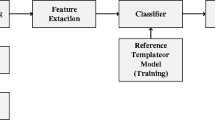Abstract
Adoption of compression technology is often required for wireless cardiovascular monitoring, due to the enormous size of Electrocardiography (ECG) signal and limited bandwidth of Internet. However, compressed ECG must be decompressed before performing human identification using present research on ECG based biometric techniques. This additional step of decompression creates a significant processing delay for identification task. This becomes an obvious burden on a system, if this needs to be done for a trillion of compressed ECG per hour by the hospital. Even though the hospital might be able to come up with an expensive infrastructure to tame the exuberant processing, for small intermediate nodes in a multihop network identification preceded by decompression is confronting. In this paper, we report a technique by which a person can be identified directly from his / her compressed ECG. This technique completely obviates the step of decompression and therefore upholds biometric identification less intimidating for the smaller nodes in a multihop network. The biometric template created by this new technique is lower in size compared to the existing ECG based biometrics as well as other forms of biometrics like face, finger, retina etc. (up to 8302 times lower than face template and 9 times lower than existing ECG based biometric template). Lower size of the template substantially reduces the one-to-many matching time for biometric recognition, resulting in a faster biometric authentication mechanism.


















Similar content being viewed by others
References
Biel, L., Petersson, O., Philipson, L., and Wide, P., Ecg analysis: A new approach in human identification. IEEE Trans. Instrum. Meas. 50(3):808–812, 2001.
Blount M. et. al, Remote health-care monitoring using personal care connect. IBM Syst. J. 46(1):95–113, 2007.
Bui, F. M., and Hatzinakos, D., Biometric methods for secure communications in body sensor networks: Resource-efficient key management and signal-level data scrambling. EURASIP J. Adv. Signal Process. 2008:Article ID 529879, 2008.
Chan, A. D. C., Hamdy, M. M., Badre, A., and Badee, V., Wavelet distance measure for person identification using electrocardiograms. IEEE Trans. Instrum. Meas. 57(2):248–253, 2008.
Hamilton, P. S., and Tompkins, W. J., Quantitative investigation of qrs detection rules using the mit/bih arrhythmia database. IEEE Trans. Biomed. Eng. BME-33(12):1157–1165, 1986.
Hung, K., and Zhang, Y.-T., Implementation of a wap-based telemedicine system for patient monitoring. IEEE Trans. Inf. Technol. Biomed. 7(2):101–107, 2003.
Irvine, J. M., et al, Heart rate variability: a new biometric for human identification. In: Int. Conf. on Arti. Intell., Las Vegas, Nevada, 2001. pp. 1106–1111, 2001.
Israel, S. A., Irvine, J. A., Cheng, A., and Wiederhold, B. K., Ecg to identify individuals. Pattern Recogn. 38(1):133–142, 2005.
Khalil, I., and Sufi, F., Legendre polynomials based biometric authentication using qrs complex of ECG. In: International Conference on Intelligent Sensors, Sensor Networks and Information Processing, 2008. ISSNIP 2008. pp. 297–302, 2008.
Lee, R.-G., Chen, K.-C., Hsiao, C.-C., and Tseng, C.-L., A mobile care system with alert mechanism. IEEE Trans. Inf. Technol. Biomed. 11(5):507–517, 2007.
Mahmood, A. N., Leckie, C. and Udaya, P. Echidna: Efficient Clustering of Hierarchical Data for Network Traffic Analysis. In: Proceedings of the fifth IFIP Networking Conference (Networking 2006): LNCS, Springer Verlag, pp. 1092–1098, 2006.
Mahmood, A. N., Leckie, C. and Udaya, P. An efficient clustering scheme to exploit hierarchical data in network traffic analysis., IEEE Transactions on Knowledge and Data Engineering (TKDE) 20(6):752–767, 2008.
Online, Health insurance portability accountability act of 1996 (hipaa), centers for medicare and medicaid services (1996). Available at: http://www.cms.hhs.gov/hipaageninfo, accessed 2008.
Online, Cardionet: Get to the heart of the problem. Available at http://www.cardionet.com/, accessed 2009.
Online, Physiobank: Physiologic signal archives for biomedical research. Available at http://www.physionet.org/physiobank/, accessed 2009.
Poon, C. C. Y., Zhang, Y. T., and Bao, S. D., A novel biometric method to secure wireless body area sensor networks for telemedicine and m-health. IEEE Commun. Mag. 44:73–81, 2006.
Sufi, F., Mobile phone programming java 2 micro edition. In: Proceedings of the 2007 International Workshop on Mobile Computing Technologies for Pervasive Healthcare, Philip Island, Melbourne. pp. 64–80, 2007.
Sufi, F., Fang, Q., Khalil, I., and Mahmoud, S. S., Novel methods of faster cardiovascular diagnosis in wireless telecardiology. IEEE J. Sel. Areas Commun. 27(4), 2009.
Sufi, F., Fang, Q., Mahmoud, S., and Cosic, I., A mobile phone based intelligent telemonitoring platform. In: Medical Devices and Biosensors, 2006. 3rd IEEE/EMBS International Summer School on ISSMDBS. pp. 101–104, 2006.
Sufi, F., and Khalil, I., An automated patient authentication system for remote telecardiology. In: International Conference on Intelligent Sensors, Sensor Networks and Information Processing, 2008. ISSNIP 2008. pp. 279–284, 2008.
Sufi, F., and Khalil, I., Enforcing secured ECG transmission for realtime telemonitoring: A joint encoding, compression, encryption mechanism. Security and communication networks. Security and Communication Networks 1(5):389–405, 2008.
Sufi, F., and Khalil, I., A new feature detection mechanism and its application in secured ECG transmission with noise masking. J. Med. Syst. 33(3):121–132, 2009.
Sufi, F., Khalil, I., and Habib, I., Polynomial distance measurement for ECG based biometric authentication (accepted and in press). Security and Communication Networks. 2009. doi:10.1002/sec.76.
Sufi, F., Khalil, I., and Hu, J., In: Stavroulakis, P. (Eds.), Ecg based biometric: The Next Generation in Human Identification. New York: Springer, 2009.
Sufi, F., Mahmoud, S., and Khalil, I., A novel wavelet packet based anti spoofing technique to secure ECG data. Int. J. of Biometrics 1(2):191–208, 2008.
Wubbeler, G., Stavridis, M., Kreiseler, D., Bousseljot, R. D., and Elster, C., Verification of humans using the electrocardiogram. Pattern Recogn. Lett. 28:1172–1175, 2007.
Yu, F., Tang, H., Leung, V., Liu, J., and Lung, C., Biometric-based user authentication in mobile ad hoc networks. Security and Communication Networks 1:5–16, 2008.
Author information
Authors and Affiliations
Corresponding author
Rights and permissions
About this article
Cite this article
Sufi, F., Khalil, I. & Mahmood, A. Compressed ECG Biometric: A Fast, Secured and Efficient Method for Identification of CVD Patient. J Med Syst 35, 1349–1358 (2011). https://doi.org/10.1007/s10916-009-9412-4
Received:
Accepted:
Published:
Issue Date:
DOI: https://doi.org/10.1007/s10916-009-9412-4




